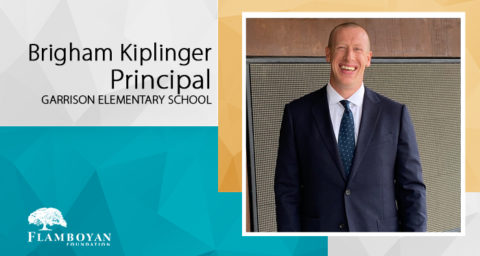
Spotlight on Garrison Principal Brigham Kiplinger.
Brigham Kiplinger has a litmus test he uses to make decisions for his school.
“It’s a powerful motivation to ask myself if a staff member, initiative, or policy we’re considering is who or what I would want for my own children,” he says. “If not, then no one else’s child should experience it either.”
The question isn’t merely theoretical. Kiplinger – known affectionately as “Principal Kip” by his students and their families — has enrolled his two sons at Garrison Elementary School, where he is entering his third year as principal. “We are becoming the kind of school I want for my own children and for all children,” Kiplinger says. “Diverse, joyful, rigorous, loving – and since I spend a lot of time and energy here, I love being able to share that experience with my own two sons.”
Kiplinger discovered that he wanted to be an educator during his undergraduate years at Cornell University, where he studied juvenile justice and spent weekends working in the nearby county jail. “A lot of the young men I was doing intake services with at the jail were functionally illiterate. Bright young men, but who hadn’t been served well by public schools in central New York. I wanted to work with young people for whom the story was not yet written. And so that took me back to my hometown, DC.”
After graduating from college, Kiplinger was accepted into Teach for America, which furthered his commitment to working with high-needs populations. After 15 years working in both charter and DC Public Schools, he arrived at Garrison with the understanding that it was his responsibility to learn from and build trust with the families he would be serving.
“We all come with our own invisible backpack of life experiences,” Kiplinger explains. “And a lot of our parents, the parents at Garrison, may or may not have had great school experiences. And I don’t expect them to know what we’re about or our vision for family partnership, and so it’s on us to essentially create the conditions that make them comfortable to go further than they may initially want to.”
Garrison staff has worked to build trust with their students’ families by adopting a model of “family partnership,” through which parents are treated as experts in their own children’s learning. “Parents are their children’s first teachers, and teachers are our children’s current teachers, and we each spend a few hours a day with children. It’s important that we be on the same page to multiply the effect of the learning.”
In addition to the typical challenges facing schools in high-needs communities, Garrison is confronting additional barriers due to its location in a rapidly gentrifying neighborhood. The surrounding area, which was once home to a freedman’s camp for liberated slaves, is now becoming overrun with luxury condos. “Our Shaw/Logan Circle community is ground zero for gentrification in DC,” Kiplinger explains. “And we are already seeing the devastating, displacing effect this can have on many of our longtime Garrison families. We must figure out how to help manage gentrification in a more equitable way, so that we can continue to be the diverse community school we have been, going back to our origins as a freedman’s village.”
Kiplinger is determined to continue serving high-needs, low-income students, but this has proved to be a challenge as wealthier families move into the community and fill the majority of in-boundary spots available at Garrison. Kiplinger says that he is happy to welcome these more privileged families to the school, but encourages them to respect the history of the neighborhood and commit to investing in it long-term.
“We want them to be here and feel a part of this community, to know its history and honor it, and to know that they are newcomers in a long lineage in Logan’s Circle, and not try to take the school over or turn it into something that fits their conception before they’ve really gotten to know it…We expect a long-term commitment to the school and community, and some humility, especially for people coming with the most privilege.”
Kiplinger, however, feels hopeful about Garrison’s ability to use the neighborhood’s recent trends to create what he calls “intentional diversity.” “Diversity across every axis is good for children. And in a gentrifying school community like ours, there is accidental diversity during this messy middle period. We have this beautiful opportunity in the middle to ensure long-term, sustainable, intentional diversity.”
Kiplinger and his staff are still figuring out how they will be able to maintain this diversity, but hopes that My School DC will someday assign lottery spots with an intentional focus on equity, or that Garrison will be able to expand to allow room for more out-of-boundary students.
“I want us to figure out how to manage gentrification in a way that is equitable and that honors our history while also evolving with the times,” Kiplinger says. “And that we have figured out how to retain families long enough to build trusting relationships, and leverage the amazing opportunity that our accidental diversity currently presents in ways that lead to excellent outcomes for all children. I don’t know of many schools like that in DC, and we have the chance to become that school, and that’s really exciting.”